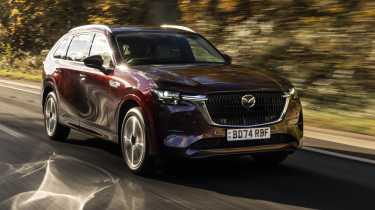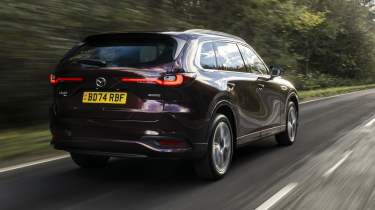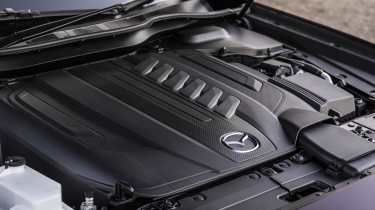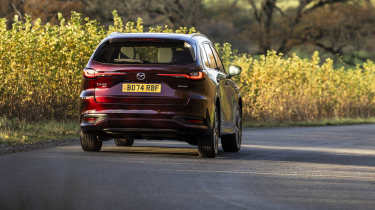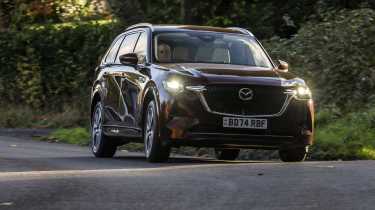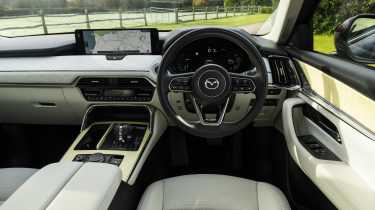Mazda CX-80 2025 review – Japan’s six-cylinder SUV eyes BMW X5
The premium SUV market gains a new entrant with the mid-sized CX-80, but it doesn’t solve the downfalls of its smaller CX-60 sibling
Mazda knows how to create a great driver’s car. The MX-5 is one of the finest on sale today, and while it doesn’t have the same driver’s appeal, the Mazda 3 hatchback gets a lot right too. Increase the seat count, though, and the appeal takes a hit, with the recent CX-60 failing to stand up to its more established rivals from Europe. Now in 2025, we find out if the latest and largest model in the marque’s lineup, the CX-80, can change that.
At a glance, it appears to be an extended wheelbase CX-60, and that’s not far from the reality. Its seven-seat layout and 4995mm length put it squarely in-line with the likes of the BMW X5 and Mercedes-Benz GLE, but its design language, trim levels and interior layout are near-identical to its smaller relative.
> Mazda CX-60 Fast Fleet test – 7000 miles in the straight-six SUV
The CX-80’s visual mass, unusual proportions and slab-sided design won’t be for some, but the powertrain options just might be. While most manufacturers are straying away from diesel, one of its two powertrain options is a black pump straight-six, with a plug-in hybrid four-cylinder option the more modern alternative. As appealing as this sounds on the surface, we find out how it translates on the road.
Engine, gearbox and 0-62 time
While most of its rivals are available with a bewildering number of powertrain options, the CX-80 makes do with just two. Though this makes understanding the range much easier, it does mean that the two options on the table need to be strong.
The plug-in hybrid petrol model is likely to be the most popular of the two, and combines a 2.5-litre turbocharged four-cylinder with an electric motor powered by a 17.8kWh battery pack. The result is a reasonable 323bhp, 369lb ft of torque and a quoted all-electric range of 38 miles. These stats put it marginally ahead the entry-level X5 in terms of output, but a 6.8sec 0-62mph is still seven tenths behind the 6.1sec of the BMW.
With the battery full, the PHEV petrol CX-80 has plenty of power on tap, with smooth electric torque making up for any lack of pull in the 2.5-litre petrol. Unlike some PHEVs, the engine doesn’t feel strained, with the integration of hybrid drive well-calibrated and unintrusive. As a result, when the engine does kick on, the cabin remains relatively quiet, although the electric motor of our test car was unusually loud at manoeuvring speeds, sounding almost like a remote control car nestled beneath the bodywork.
The 3.3-litre straight-six diesel is a more conventional offering, but does still come with mild hybrid assistance in-keeping with Mazda’s goal of a fully electrified range by 2030. As with most mild-hybrids the electrification is virtually undetectable, with its use limited to starting the engine, allowing for engine-off coasting and providing an overall boost to efficiency should the conditions be right.
Though it does have two more cylinders and a reasonable displacement advantage, the diesel takes a power hit over the PHEV at 251bhp, but a higher 407lb ft torque figure and 108kg weight advantage more than make up for it. It might have a slower 8.4sec 0-62mph time (considerably slower than most of its German rivals), but a satisfying, purposeful straight-six sound and smooth, predictable power delivery make it a nice engine to live with. It won’t break any performance records but it delivers enough performance for the chassis it’s tasked with moving (more on that later). Mazda also claims that the diesel is the best in its class for both emissions and economy with a quoted 48.7mpg combined (WLTP), though we found it to be not so great in the real-world in the CX-60.
Ride and handling
The CX-80’s smaller CX-60 sibling was severely lacking in dynamic sophistication in its earlier form, with it struggling to manage its mass and feeling half-baked in more ways than one. Given the increase in the dimensions and kerb weight with the CX-80, the result is just as you’d expect.
In PHEV-form, kerb weight stands at an eye-watering 2889kg (177kg of which is the battery), with the diesel marginally less at 2781kg. Mazda says it has made significant chassis changes to both the CX-60 and -80 in efforts to rectify the issues we experienced in earlier cars, but it’s still not a match for its more premium European rivals. Body control is lacking at any speed, with roll significant and unsophisticated damping making British B-roads a bad fit for the CX-80 – on a smoothly paved surface the experience is relatively refined, but on the vast majority of our roads, it thumps over imperfections and struggles to settle.
Steering isn’t as frustratingly light as in some of its rivals, but its added heft doesn’t make for an improvement in response or feel. The rack is slow, turning circle poor and once you’ve made it past the off-centre dead spot, any initial steering response is lost in unwanted body movement. Make a quick steering input and there’s a tangible delay between the input and response, with the front and rear seeming to respond at different rates. Thankfully though, it doesn’t require much correction on a straight road, making it relatively stress-free for long miles.
Though a little grabby on first application, brakes are adequate for the task at hand, with a sturdy, consistent pedal. The mild-hybrid diesel has a more consistent pedal than the PHEV due to the lack of regenerative braking, but both are reasonably well judged.
Interior and tech
The cabin is where the CX-80 excels. Our Takumi-trim test cars felt undoubtedly premium, with great build quality, excellent materials and a tasteful design to set the CX-80 apart from anything in its price bracket. The flat-sided doors close with a bit of a twang like most modern Mazdas, but there’s not much else to knock.
While more basic trim levels go without, you can have real open-pore wood trim, plush Nappa leather seats and unique, stitched recycled fabric trim on the dash if you select the right options – we’re not sure how the pale fabric will fare with age, but it looks great out of the box. There’s also some sharp chrome trim spanning the width of the dash and flowing into the door cards, with a finish akin to an upmarket coffee machine.
The sharp central infotainment is easy to read, neatly integrated and comes with wireless Apple Carplay and Android Auto as standard, with the digital dash following the same theme. The use of satisfying, tactile physical buttons for all frequently accessed controls is refreshing, with the steering wheel tastefully thin-rimmed for a car of this kind. The cabin feels as if it’s had some real thought put into it, which is something that can’t be said for the chassis beneath it.
Most UK buyers are likely to buy the seven-seat configuration, but the CX-80 is also available with six seats, turning second row seats into captain’s chairs with an integrated centre console.
Price, specs and rivals
The CX-80 range begins with the Exclusive Line with 18-inch wheels and wireless Apple Carplay and Android Auto as standard, but lift the budget to £52,820 and the Homura spec comes into reach, adding 20-inch wheels, Nappa leather, more body colour exterior trim and window sunshades to the mix. You can then opt for Homura, Homura Plus, Takumi or Takumi Plus to top the range, with its £56,420 base price. The PHEV four-cylinder powertrain is the cheapest of the two, despite its higher power output, with the 3.3-litre diesel carrying a £2745 premium in Takumi Plus spec
A £49,670 starting price makes the Mazda CX-80 £4300 more expensive than its smaller CX-60 sibling, but with the BMW X5, Mercedes-GLE and Audi Q7 starting from £72,335, £75,445 and £69,810 respectively, it looks a relative bargain.
